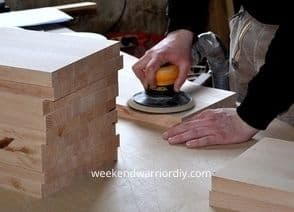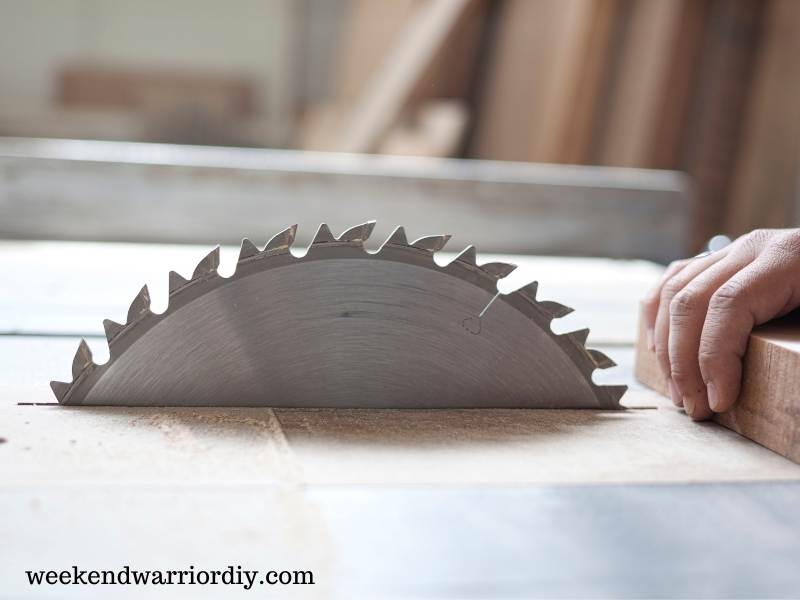I am amazed at the growing amount of interest in woodworking. It seems like every second or third home has someone in it that will tell you they enjoy woodworking. I remember 30 to 40 years ago when people heard I did woodworking – they would look at me like I had some special quality they wish they possessed! Now it seems every other person you talk to says they do woodworking to some degree.
To get into woodworking, first you need the desire to create something out of wood. A creative mind is preferable but not always necessary. To perform anything woodworking-related, you will need a safe place to set up tools for use. Some money for wood and tools is also required.
It sounds obvious by my last sentence that you will need money for wood and tools, but people will forget that even if you have some power tools, you still need supplies. You will likely need to buy materials for every project.
Yes, eventually you will have left over materials to use but unless you are making the same things over- and-over again, you are going to be buying new materials constantly. I am not trying to scare you away from the hobby – I just want you to be aware of some of the logistics involved.
How Does a Person Start Off in Woodworking?
This is the magic question, however – how do you get into woodworking?
Some people (like myself) have parents and grandparents who were carpenters. I also began in the trades to start off my working career. Not as a carpenter, but I worked with carpenters and other tradesmen.
So, it is easy to get into woodworking if you have been exposed to the trade. I will assume though, if you are reading this article, that you have not been exposed to much woodworking or you probably would not need to read this!
I can see how someone would be interested in getting started with woodworking. It is a fun skill to learn and it can both save and make you money.
Whether you want to learn how to frame a basement, build an entertainment center or build and sell birdhouses, here is how you can get started.
- Identify what kind of woodworking/carpentry it is you want to learn. Someone who wants to learn how to frame basements will need different skills and tools compared to someone who wants to cut out intricate pictures using a scroll saw.
- Once you know what you want to be woodworking on most of the time, the next thing to identify is what tools are used when creating those projects. If you are just wanting to frame basements, there is no reason to run out and buy a shop size table saw.
- Having a safe place to do your woodworking is extremely important. It does not have to be an area that is solely dedicated to woodworking. I know people who use areas of their home that are used for other things but when needed, they move things around and pull out their tools to do some woodworking. If you are interested in woodworking in an apartment, check out this article I wrote on the subject.
If you have a garage, you can easily pull out your vehicle and roll out your tools for some woodworking. A garden shed can work as well. If you are lucky enough to have a dedicated workspace, then all the better.
- If you are interested in taking woodworking classes, you can learn the foundation to help you with all projects in the future. If classes are not possible, then head on over to YouTube and start watching videos on whatever woodworking it is you are interested in.
You can learn a lot of things from people on YouTube that have the skills to do what you want to learn to do. My only caution with learning from YouTube is to be cautious if you are being told something and it does not make sense to you. Use your common sense, in other words.
My channel is just getting started but over time, I will have videos with all kinds of great woodworking information. Check it out at weekendwarriordiy on YouTube.
- Lastly, regardless of what you want to get into, do yourself a favor and head over to Pinterest for ideas. I am always amazed at how many ideas I get when I look at pins on Pinterest. I have enough projects saved to last me the next 20 years!
Being proactive with your desire to learn woodworking is the best way to get started.
How Much Does It Cost to Get into Woodworking?
Cost is always a factor, regardless of what new activity you get into. For woodworking, you are looking at the cost of tools, workbenches, dust recovery, safety gear, wood, stains, paints, nails, screws among other necessary supplies.
If you are lucky enough to have someone you can borrow tools from or take their scrap wood for your projects, then your cost will go down.
If I were just starting in woodworking without any experience or tools, here are the costs I would incur when getting started. This is for someone who wants to begin woodworking in their garage on fun projects they find on Pinterest.
You will always need to take safety seriously or you could one day get seriously hurt. Here are some items you will want to invest in for safety. As with anything these days, there are always wide price ranges. I am providing you the dollar amount I feel you will be okay spending. You are free to upgrade and spend more if you want.
- Safety glass will be needed if you are working with any power tools. Look to spend about $15 on safety glasses. If you are using a table saw, look for larger safety goggles to protect more of the area around your eyes. You can also purchase full face shields to protect your whole face and are much easier to use if you wear prescription glasses. Full face shields will cost you about $50.
- Protective earmuffs will help protect your hearing. The decibel levels on power tools vary and can be quite loud. If you do not protect your ears, you can easily damage them. I have tinnitus and I fully blame it on loud power tools (or perhaps rock concerts). Ear protection will cost you less than $20.
- Work gloves will save you from painful slivers. Do yourself a favor and get work gloves that fit snug so you get the protection you need and are able to feel the wood. Being able to maneuver wood as if you had no gloves on will make using tools like bandsaws, scroll saws or the like that much easier. Spend about $15 on good gloves.
- Dust masks are important to protect you from inhaling small particles such as wood dust (sawdust) or tiny floating particles of paint. Be aware there are different masks for different types of protection. I recommend having masks for sawdust and masks for protection from paints and sprays. Look to spend at least $30 and have a few extras on hand. Do not take your lung health for granted.
How Much do Woodworking Tools Cost and Which Ones are Essential?
Next up for consideration is the cost of tools and benches. Again, I will give you a price range to shoot for but if you have the budget, then feel free to spend more. Just make sure before buying expensive power tools that you are really going to use them. If you end up not really enjoying woodworking, recouping most of the money you spend on power tools is not going to happen, however.
- Before we get into tools, let’s talk about workbenches. You will need bench space to place tools on and workspace to put your materials together and then finish with paint, etc. Depending on your space, you will need a workspace for each of those things or use one bench and switch out using power tools from assembly to finishing.
The cost for a bench can be very costly if you purchase one. You can however, build your own for less than $100 and it will last you for as long as you need it. If you purchase a metal bench, you will end up having to spend $300 to $500.
If you build your own (which I highly recommend), look for plans online for a 2’x4’ bench size. It is a good one to start with. All you will need to buy are 2×4’s and ⅝” to ¾” pieces of plywood and a small container of construction screws (use construction adhesive as well).
The tools you purchase will depend on what projects you plan on completing. Make sure you really need the tools you are buying. Do some research and find out if you really need a table saw or can you use a circular saw? Do you need a scroll saw or can you use a bandsaw?
In this next section, let me give you my recommendation for what power tools most woodworking shops should possess and what you can expect to pay for each.
These are in no particular order. The tools you purchase will depend on what projects you want to do. We are going to cover circular saws, drills, jigsaws, bandsaws, scroll saws, routers, air nailers, table saws and mitre saws.
- Circular saws are a must have tool in 99% of all woodworking shops, especially if you do not have a table saw. A circular saw will help you on most projects even if it is just squaring up the ends of the wood. If you buy a corded circular saw, you can expect to spend under $100. A cordless circular saw will cost you much more.
- Cordless and corded drills are a must. I own both and recommend you get one of each. If you just need to drill small holes or use the drill as a screwdriver, then a cordless drill will be good enough for you. If, however, you think you will need more power for drilling larger holes or for mixing drywall mud, then a corded drill is a must.
A good cordless drill will cost you about $70 to $100 and a corded drill will cost about $60. You can spend quite a bit more on drills but when you are first starting out, drills in these price ranges will be sufficient for you.
- Jigsaws, bandsaws and scroll saws are all power tools you might consider owing. Out of the three, I highly recommend getting yourself a jigsaw. Jigsaws can be used to cut all kinds of thicknesses in wood and can make inside cuts which you might find you need. A decent jigsaw will only cost you about $60, especially if you watch for a sale.
As far as bandsaws or scroll saws go, if you have the budget, you can’t go wrong with a tabletop bandsaw to start off. A decent one for a hobby woodworker will run you around $150. Watch for sales and grab yourself a good one at a great price.
Scroll saws are fun pieces of equipment to own however, they are more for woodworkers who plan on spending quite a bit of time making intricate inside cuts. If you plan on making a lot of woodwork pieces you see on Pinterest, then you might need a scroll saw. Otherwise, I would not recommend investing in one of these when you are just getting started.
- If the projects you are going to be doing will have any sort of finished edge, then a router is a must to have. Routers can not only edge wood in fun ways making everything you do look professional, but they can make other cuts such as keyholes in the back of pieces to be hung on walls. As well, they can be used in lieu of a dado blade for making shelving and cabinets.
The cost of a decent router will be somewhere around $100 to $200. Grab yourself a plunge router and if you can afford a cordless one then, treat yourself to one of those.
- An air nailer is a wood workers best friend and a must have wood worker’s tool. Gone is the day of completing a wood project with finishing nails. Brad nails are the way to go.
- When it comes to air nailers, the one you need will be dependent on what length nails you will use. Buying a standard 18-gauge nailer will have you covered for most projects. If you plan on using very thin wood, then a pin nailer might be something to invest in.
- With an air nailer, you will need a compressor. For just starting out, watch for sales on compressor and air nailer packages. You can get good deals and do not need a huge compressor, unless you plan on framing walls with an air nailer. A 4-gallon will be big enough for most projects out of your garage.
- Look to spend about $400 on a decent compressor and air nailer combo.

- Table saws are a large piece of woodworking equipment that are not always needed when woodworking. A lot of the cuts you can do with a table saw you can also do with a circular saw.
If you really think a table saw is a tool you need in your woodworking workshop, either incorporate one into your workbench when you build it or purchase a jobsite table saw that can be moved around your workshop easily. You can use a workbench for a run-off table.
I would not cheap out on a table saw. Purchase the most expensive one you can afford. Get one that has excellent ratings and test the one you want before buying it. You should always feel comfortable with the tool you are using.
The cost of a decent table saw will be around $500.
- Lastly, miter saws are not on my list for tools you should have when you first start off however, you might select a miter saw over a table saw, especially if you have a circular saw already.
All the cuts you can do on a miter saw can be done with a circular saw. The main differences are the accuracy of the cuts with a miter saw and being able to cut a lot of pieces of the same length go much quicker with a miter saw.
For a decent miter saw you will be paying around $200.
How Much do Wood and Supplies for Woodworking Cost?
The wood you purchase will differ immensely. It is really hard for me to tell you what the wood will cost because I don’t know what project you are working on. The best way to get these costs is to check out your local lumber yard and see what they charge for materials.
What I would like to tell you, however, is to plan out your projects in advance and know exactly how much and what types of wood you need before you go looking for it. Do not over buy at first – just get the materials you need for one job.
Over time, you will accumulate wood and have an excess, just like every other woodworker out there.
For costs of lumber, you can spend as little as $2 for a 1×2 or hundreds of dollars for some really nice live-edge materials.
Always keep your eyes open for free wood. I recommend posting something on your Facebook page asking friends if they have any extra wood they don’t want that you would be happy to take it off their hands! You may be pleasantly surprised at the responses you get.
As with buying wood, the materials you will need to put a project together and finish it off will vary from project to project. Do your due diligence – know what supplies you need and do not purchase more than you need. Over time, you will accumulate a ton of supplies even when trying not to. It is just the way it seems to go with woodworking.
How to Get Started with Woodworking?
Once you have your designated space and some new power tools, what do you do next?
Getting started with woodworking is as simple as selecting a project and gathering the materials needed to accomplish it. Take some time and just start.
Always get to know your power tools, especially if you are ‘green’ to woodworking. Research how to use your new power tools and how to maintain them. Do not discount the importance of understanding how the tools work and the power they possess.
Power tools are dangerous. If you are reckless with them, you can be seriously hurt or worse.
Once you get started on a project, do not be surprised if it does not go as well as you had hoped. Woodworking is an acquired skill that takes time to perfect. Even skilled woodworkers make mistakes.
Depending on the project, sometimes it is the imperfections that make our woodworking unique so do not be hard on yourself. Just appreciate the process and keep moving forward.
Conclusion
To wrap things up, I would like to touch on a couple things…
Getting into woodworking will cost you money for tools and supplies. There is no getting around that. For somewhere around $2,000, you can acquire enough tools and supplies to easily get started on just about any woodworking project.
As far as beginning, it is just a matter of getting set-up and then moving forward. You are not going to learn if you keep making excuses not to start. Analyzing and searching for the perfect first projects can lead to analysis paralysis which means you will spend your time looking for something to work on but never really getting started!
Find a simple project and just do it! It may be your first workbench or maybe a candle holder. The point is to just start cutting and creating something out of wood. Over time, you will learn what you enjoy doing most.
I hope this article has been of help to you. Thanks for taking the time to read it. Good luck on your woodworking journey.
Related Posts
Should You Buy a Trim Router or Plunge Router? A Comprehensive Guide
Is Being a Handyman a Good Job? (11 Tips to Help You Make the Decision)
Can You Use Pressure Treated Wood for Shou Sugi Ban?



